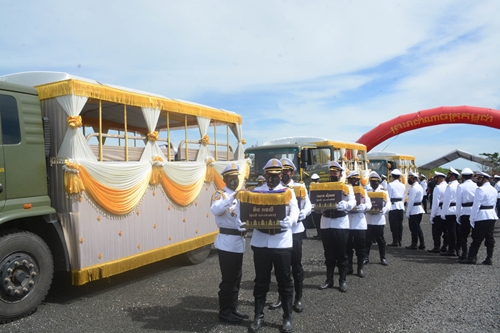The ceremony was attended by Senior Lieutenant General Do Can, Deputy Director of the General Department of Political Affairs of the Vietnam People's Army, Standing Vice Chairman of the Government’s specialized committee of the Socialist Republic of Vietnam; leaders of the central ministries and sectors, the Military Region 7 Command, Binh Phuoc and Dong Nai provinces, and the Ministry of National Defense. The Cambodian side included General Sao Sokha, Deputy Commander-in-Chief of the Royal Cambodian Armed Forces and Commander of the Royal Cambodian Gendarmerie, agencies of the Cambodian Ministry of National Defense, and leaders of several Cambodia localities.
    |
 |
|
Senior Lieutenant General Do Can (right, front) and General Sao Sokha at the handover ceremony |
Forty nine sets of remains were fallen soldiers of Division 125, the predecessor of Cambodia’s united armed forces for national salvation (currently the Royal Cambodian Armed Force). They died due to injuries in fighting in Cambodia or illnesses, and were buried in Vietnam. The area was later turned into a cemetery and built into a historical site, which is a symbol of the pure and faithful solidarity and friendship bonds between the two nations and militaries. The sets of remains were excavated by the forces of the two defense ministries at Group 125 historical relic site in Long Giao townlet, Cam My district, Dong Nai province.
Addressing the hand-over ceremony at the X-16 area in Binh Phuoc province, Sr. Lt. Gen. Do Can, Deputy Director of Vietnam People's Army (VPA)'s General Department of Political Affairs and Standing Vice Chairman of the Government’s specialized committee, recalled that after the victory of the anti-U.S. resistance war, the Cambodian people hoped to live in peace and national harmony for national construction, but the Cambodian revolution was betrayed by the Pol Pot - Ieng Sary group, which implemented a genocidal policy, killing millions of Cambodians. They also sent troops to the border with Vietnam, attacking Vietnamese localities and killing tens of thousands of innocent Vietnamese.
The Cambodian people along with genuine Cambodian revolutionaries rose to fight against the genocidal regime. The genuine Cambodian revolutionaries, led by Hun Sen (now the Prime Minister of Cambodia), traveled to Vietnam to build up their forces.
    |
 |
|
The remains of Cambodian soldiers are brought to the homeland. |
At the request of PM Hun Sen and the wish of relatives of the 49 dead officers and soldiers, the Vietnamese PM agreed to repatriate the remains to Cambodia. Working teams of both sides have coordinated closely to complete the excavation of the remains to return them to Cambodia.
Speaking at the event, Gen. Sao Sokha, Deputy Commander-in-Chief of the Royal Cambodian Armed Forces and Commander of the Royal Cambodian Gendarmerie, expressed thanks to Vietnam for dedicating the site for the burial of the Cambodian officers and soldiers and for taking care of their graves over the past 45 years.
Translated by Chung Anh